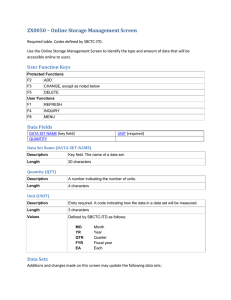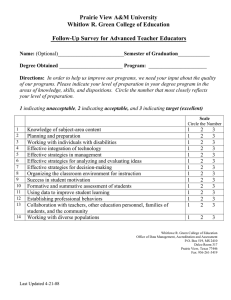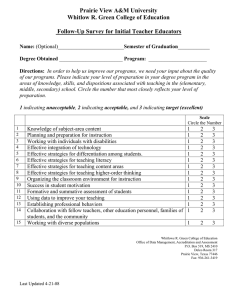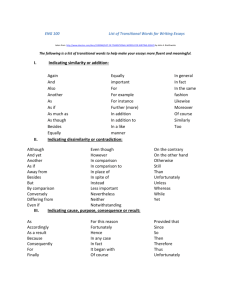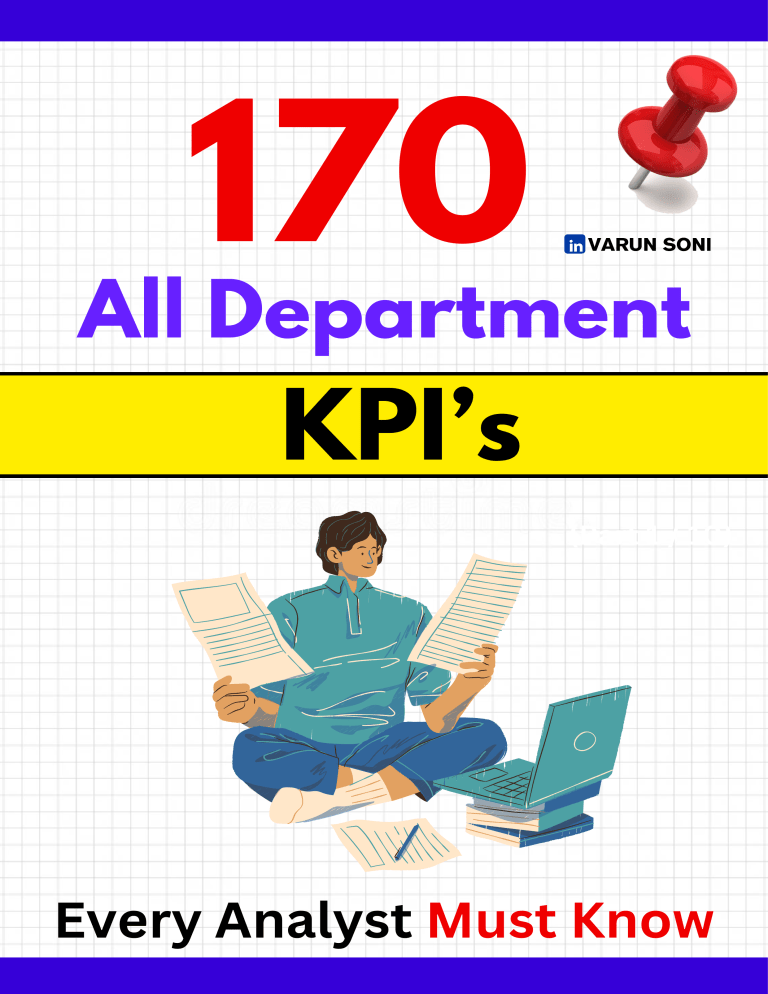
170 VARUN SONI All Department KPI’s (Part 1 / 10) Every Analyst Must Know SALES: VARUN SONI New Inbound Leads: The number of new potential customers or contacts who have initiated contact with your business through inbound channels. Lead Response Time: The time it takes for your team to respond to new leads after they've made initial contact, is usually measured in minutes or hours. Lead Conversion %: The percentage of leads that successfully convert into customers or qualified opportunities. New Qualified Opportunities: Newly identified potential deals or prospects that meet specific criteria for qualification. Total Pipeline Value: The combined value of all potential deals or opportunities in your sales pipeline. Lead-to-Opportunity %: The percentage of leads that progress into qualified opportunities in your sales pipeline. Opportunity-to-Order %: The percentage of qualified opportunities that ultimately result in a successful sale or order. Average Order Value: The average monetary value of each sale or order made by your business. Average Sales Cycle Time: The average duration it takes for a lead to progress through the sales process, from initial contact to closing a deal. Upsell %: The percentage of existing customers who purchase additional or upgraded products or services. VARUN SONI Cross-Sell %: The percentage of customers who buy complementary products or services in addition to their initial purchase. Sales Volume by Location: The distribution of sales revenue across different geographical locations. Sales Change (YoY, QoQ, MoM): The percentage change in sales revenue compared to the same period in the previous year (YoY), the previous quarter (QoQ), or the previous month (MoM). Sales Target %: The percentage of your sales target that has been achieved within a given period. MANAGEMENT: Customer Acquisition Cost (CAC): The average cost incurred by a business to acquire a new customer, including marketing and sales expenses. Customer Lifetime Value (CLV): The predicted net profit generated by a customer over the entire duration of their relationship with a business. Customer Satisfaction Score (CSAT): A metric that measures the level of satisfaction customers have with a company's products or services. Sales Target % (Actual/Forecast): The percentage of the sales target that has been achieved, compared to the actual sales made or the forecasted sales. Sales by Product or Service: The revenue generated by each specific product or service offered by a company. Customer Acquisition Cost (CAC): The average cost incurred by a business to acquire a new customer, including marketing and sales expenses. VARUN SONI Customer Lifetime Value (CLV): The predicted net profit generated by a customer over the entire duration of their relationship with a business. Customer Satisfaction Score (CSAT): A metric that measures the level of satisfaction customers have with a company's products or services. Sales Target % (Actual/Forecast): The percentage of the sales target that has been achieved, compared to the actual sales made or the forecasted sales. Sales by Product or Service: The revenue generated by each specific product or service offered by a company. Revenue per FTE (Full-Time Equivalent): The amount of revenue generated per full-time equivalent employee, indicating productivity. Revenue per Customer: The average amount of revenue generated from each individual customer. Operating Margin: The percentage of revenue that remains after deducting operating expenses, indicating operational efficiency and profitability. Gross Margin: The percentage of revenue that remains after subtracting the cost of goods sold (COGS), indicating the profitability of a company's core business activities. Return on Equity (ROE): A measure of a company's profitability relative to shareholders' equity, indicating how effectively a company is utilizing its equity to generate profits. Return on Assets (ROA): A measure of a company's profitability relative to its total assets, indicating how efficiently a company is using its assets to generate profits. VARUN SONI Current Ratio (Assets/Liabilities): A financial ratio that measures a company's ability to cover its short-term liabilities with its short-term assets, providing insight into liquidity and financial health. Debt to Equity Ratio: A financial ratio that compares a company's total debt to its total equity, indicating the proportion of debt financing relative to equity financing. Working Capital: The difference between a company's current assets and current liabilities, representing its ability to meet short-term financial obligations. Employee Satisfaction Rating: A metric that measures the level of satisfaction and engagement among employees within a company. PROJECT MANAGEMENT: On-Time Completion %: The percentage of tasks, projects, or deliverables completed within the scheduled time frame. Milestones on Time %: The percentage of project milestones that are completed on schedule. Estimate to Project Completion: The projected time or date when a project is expected to be finished based on current progress and estimates. Adjustments To Schedule: Changes made to the project timeline or schedule to accommodate unforeseen circumstances or changes in priorities. Planned vs. Actual Hours: A comparison of the estimated time planned for a task or project against the actual time spent on it. Resource Capacity %: The percentage of available resources (such as manpower, equipment, or funds) that are currently being utilized. VARUN SONI Budget Iterations: The number of times the project budget has been revised or adjusted throughout its lifecycle. Planned Value: The estimated value of the work planned to be completed at a specific point in time, often used in earned value management. Net Promoter Score (NPS): A metric used to measure customer satisfaction and loyalty based on the likelihood of customers to recommend a company's products or services to others. Number of Errors: The total count of mistakes or defects identified during a project or in a product/service. Customer Complaints: The number of formal complaints or grievances raised by customers regarding products, services, or interactions with the company. Change Requests: Formal requests to modify the scope, timeline, or budget of a project. Billable Utilization: The percentage of time that employees spend working on billable tasks or projects compared to total working hours. Return On Investment (ROI): A measure of the profitability or efficiency of an investment, calculated as the ratio of the net gain or loss relative to the initial investment. MARKETING: VARUN SONI Marketing Qualified Leads (MQLs): Leads that have been identified by marketing as having a higher likelihood of becoming customers based on certain criteria or behaviors. Sales Qualified Leads (SQLs): Leads that have been evaluated and deemed ready for direct sales engagement based on specific criteria set by the sales team. Cost per Lead: The average cost incurred to acquire each new lead, calculated by dividing total marketing expenses by the number of leads generated. New Customers: The number of customers acquired within a specific period, indicating the effectiveness of marketing and sales efforts in converting leads into paying customers. Cost per Acquisition (CPA): The average cost incurred to acquire each new customer, calculated by dividing total marketing and sales expenses by the number of new customers acquired. Upsell & Cross-Sell Rates: The percentage of existing customers who purchase additional or complementary products or services (upsell), and the percentage of customers who buy different products or services in addition to their initial purchase (cross-sell). Conversion Rates (For Specific Goals): The percentage of visitors or leads who take a desired action, such as making a purchase, filling out a form, or signing up for a newsletter, indicating the effectiveness of marketing campaigns. Social Program ROI (By Platform): The return on investment generated from social media marketing efforts on specific platforms, calculated by dividing the revenue generated from social media activities by the total cost of those activities. VARUN SONI Organic Traffic & Leads: The number of website visitors and leads generated through unpaid, organic channels such as search engines, social media, or referrals. Return on Ad Spend (ROAS): The ratio of revenue generated from advertising campaigns to the cost of those campaigns, indicating the effectiveness of advertising efforts in driving sales. Average Order Value (AOV): The average monetary value of each transaction or order placed by customers, calculated by dividing total revenue by the number of orders. Total Revenue: The overall income generated by a business from sales of products or services within a specific period. Revenue by Product or Service: The distribution of total revenue across different products or services offered by a business, indicating the performance and popularity of each offering. Customer Lifetime Value (CLV): The predicted net profit generated by a customer over the entire duration of their relationship with a business, taking into account factors such as repeat purchases and retention. Net Promoter Score (NPS): A metric used to measure customer satisfaction and loyalty based on the likelihood of customers to recommend a company's products or services to others. OPERATIONS: Labor Utilization: The percentage of time that employees spend actively engaged in productive work tasks compared to total available working hours. Employee Turnover Rate: The percentage of employees who leave a company within a certain period, typically calculated annually. Employee Absence Rate: The percentage of scheduled work hours missed by employees due to unplanned absences, sickness, or other reasons. VARUN SONI Employee Training Rate: The percentage of employees who participate in training and development programs to enhance their skills and knowledge. ROI of Outsourcing: The return on investment gained from outsourcing certain tasks or functions to external vendors or service providers. Labor Materials: The cost associated with labor and materials required for production or service delivery. Operating Margins: The percentage of revenue that remains after deducting operating expenses from total revenue, indicating the profitability of core business operations. Customer Lifetime Value (CLV): The predicted net profit generated by a customer over the entire duration of their relationship with a business, taking into account factors such as repeat purchases and retention. Processes and Procedures Developed: The number or percentage of new processes or procedures implemented to improve efficiency, quality, or compliance within the organization. Cash Flow: The movement of money in and out of a business, including revenue, expenses, investments, and financing activities, measured over a specific period. Project Schedule Variance: The difference between the planned schedule for a project and the actual schedule at a specific point in time. Order Fulfillment Cycle Time: The total duration it takes from receiving an order to delivering the product or service to the customer. Delivery In Full On Time Rate: The percentage of orders that are delivered complete and on time as promised to customers. VARUN SONI Rework Rate: The percentage of completed work that requires rework or correction due to errors, defects, or customer dissatisfaction. Customer Complaints: The number or frequency of formal complaints or grievances raised by customers regarding products, services, or interactions with the company. CUSTOMER CARE: Number of Issues (By Type): The total count of customer issues or inquiries categorized by type, such as technical, billing, or product-related problems. First Response Time (FRT): The time taken by customer support or service team to respond to a customer's initial inquiry or issue. First Contact Resolution Rate: The percentage of customer issues or inquiries resolved during the first interaction with customer support or service. Average Response Time: The average time taken by the support team to respond to customer inquiries or issues. Average Resolution Time: The average time taken by the support team to resolve customer issues or inquiries. Most Active Support Agents: The customer support agents who handle the highest volume of customer inquiries or issues. Cost Per Conversation: The average cost incurred by the company for each customer support conversation or interaction. Customer Satisfaction Score (CSAT): A metric used to measure the satisfaction level of customers based on their experience with the company's products or services. VARUN SONI Net Promoter Score (NPS): A metric used to measure customer loyalty and satisfaction based on the likelihood of customers to recommend the company to others. Positive Customer Reviews: The number of positive reviews or feedback received from customers regarding their experience with the company's products or services. Customer Effort Score: A metric used to measure the ease of doing business with a company, typically based on the level of effort required by customers to resolve issues or inquiries. Customer Retention Rate: The percentage of customers retained by the company over a specific period, indicating customer loyalty and satisfaction. Support Costs / Revenue Ratio: The ratio of customer support costs to total revenue generated by the company, indicating the efficiency of support operations relative to revenue. Knowledge Base Articles: The number of articles or resources available in the company's knowledge base to help customers self-service and find solutions to their issues. Employee Engagement: A measure of the level of involvement, enthusiasm, and commitment employees have towards their work and the organization. FINANCE: Gross Profit Margin (and %): The percentage of revenue that exceeds the cost of goods sold (COGS), indicating the profitability of a company's core business activities. Operating Profit Margin (and %): The percentage of revenue that remains after deducting operating expenses, indicating the profitability of a company's operations before interest and taxes. Net Profit Margin (and %): The percentage of revenue that remains after deducting all expenses, including taxes and interest, indicating the overall profitability of a company. VARUN SONI Operating Expense Ratio: The ratio of operating expenses to total revenue, indicating the proportion of revenue used to cover operating costs. Working Capital Ratio: The ratio of current assets to current liabilities, indicating a company's ability to cover short-term financial obligations with its current assets. Debt-To-Equity Ratio: The ratio of total debt to total equity, indicating the proportion of financing provided by creditors compared to shareholders. Quick Ratio (Acid Test): The ratio of quick assets (current assets minus inventory) to current liabilities, providing a more conservative measure of a company's ability to cover shortterm liabilities. Current Ratio: The ratio of current assets to current liabilities, indicating a company's ability to cover short-term obligations with its current assets. Berry Ratio: The ratio of earnings before interest and taxes (EBIT) to total assets, used to evaluate a company's profitability relative to its asset base. Return on Assets (ROA): The ratio of net income to total assets, indicating a company's efficiency in generating profits from its assets. Cash Conversion Cycle: The length of time it takes for a company to convert its investments in inventory and other resources into cash flow from sales. Accounts Payable Turnover Ratio: The ratio of purchases made on credit to the average accounts payable outstanding during a specific period, indicating how quickly a company pays its suppliers. Accounts Receivable Turnover Ratio: The ratio of net credit sales to average accounts receivable outstanding during a specific period, indicating how quickly a company collects payments from its customers. VARUN SONI Budget Variance: The difference between actual expenses and budgeted expenses, indicating whether a company is over or under budget. Payroll Headcount Ratio: The ratio of total payroll expenses to the number of employees, indicating the average cost of labor per employee. HR ANALYST: Absenteeism rate: The percentage of scheduled work hours missed by employees due to unplanned absences. ROI of outsourcing: The return on investment gained from outsourcing certain tasks or functions to external vendors or service providers. Succession planning rate: The rate at which positions within the organization are successfully filled by internal candidates through succession planning initiatives. Open/closed grievances: The number of unresolved (open) and resolved (closed) employee grievances or complaints. Promotion rate: The rate at which employees are promoted within the organization. Time to productivity: The time taken by new employees to reach full productivity and effectiveness in their roles. Successor gap rate: The rate at which key positions within the organization remain vacant due to a lack of suitable internal successors. Worker composition by gender, experience, and tenure: The demographic breakdown of the workforce based on gender, level of experience, and length of employment. Internal mobility: The rate at which employees move between different roles or departments within the organization. Manager quality index: A measure of the effectiveness and leadership quality of managers within the organization. HR effectiveness: An assessment of the efficiency and effectiveness of HR processes and initiatives. Employee satisfaction rates: The level of satisfaction and engagement among employees within the organization. Training ROI: The return on investment gained from training and development programs for employees. HR Compensation: HR functional operating expense rate: The ratio of HR functional operating expenses to total revenue. Labor cost per FTE: The average labor cost per full-time equivalent employee. Labor cost revenue percent: The percentage of revenue spent on labor costs. Labor cost revenue expense percent: The percentage of expenses spent on labor costs relative to revenue. Total benefits as percentage of labor costs: The percentage of labor costs attributed to employee benefits. Revenue per FTE: The revenue generated per full-time equivalent employee. Profit vs. compensation per FTE: The comparison between profit generated and compensation expenses per full-time equivalent employee. Human capital ROI: The return on investment gained from human capital expenditures. HR functional cost per employee: The average cost of HR functions per employee. VARUN SONI VARUN SONI Recruitment: Quality of hire: The effectiveness and suitability of new hires. Vacancy rate: The percentage of vacant positions relative to total positions. Turnover rate: The rate at which employees leave the organization. Resignation/retirement rate: The rate at which employees resign or retire. External hire rate: The percentage of new hires recruited externally. Time-to-fill: The average time taken to fill open positions. Diversity, experience, and gender hire ratio: The ratio of hires based on diversity, experience, and gender. Recruiting funnel metrics: Metrics related to various stages of the recruitment process. Talent import/export ratio: The ratio of talent imported (hired) and exported (left the organization). Voluntary turnover rate: The percentage of employees who voluntarily leave the organization. Retention rate: The rate at which employees are retained within the organization. Recruiting expense per new hire: The average cost incurred to recruit and hire a new employee. Retirement rate forecast: The predicted rate at which employees will retire from the organization. VARUN SONI IT: Total Support Tickets: The total number of tickets or requests received by the IT support team for assistance or issue resolution. Open Support Tickets: The number of support tickets that are currently unresolved or pending resolution. Ticket Resolution Time: The average time taken by the IT support team to resolve a support ticket, from the time it is opened to when it is closed. Reopened Tickets: The number of support tickets that were previously closed but have been reopened due to unresolved issues or recurring problems. Average Time Between Failures: The average duration between failures or system downtime incidents, indicating the reliability of IT infrastructure. Average Time to Repair: The average time taken by IT personnel to repair or restore functionality after a failure or incident occurs. Uptime %: The percentage of time that IT systems or services are operational and available for use, indicating system reliability. Server Downtime: The total duration of time that servers are unavailable or offline, usually measured in hours or minutes. Security Related Downtime: The downtime caused by security incidents, breaches, or vulnerabilities in IT systems. Total Projects: The total number of IT projects undertaken within a specific period. Projects on Budget: The percentage of IT projects completed within the allocated budget. VARUN SONI Critical Bugs: The number of critical or high-priority software bugs identified within IT systems. IT Support Employees Per End Users: The ratio of IT support staff members to end users or employees supported. IT Costs vs Revenue: The ratio of IT expenses to total revenue generated by the organization, indicating the proportion of revenue allocated to IT investments and operations. IT Team Turnover: The rate at which employees leave the IT department, often expressed as a percentage of the total IT workforce. SOCIAL MEDIA: Social Share of Voice (SSoV): The percentage of total online conversations or mentions within a particular industry or topic that a brand or entity owns. Total Reach: The total number of unique users who have been exposed to a social media post or campaign. Total Impressions: The total number of times a social media post or campaign has been displayed on users' screens, regardless of whether it was clicked or engaged with. Followers or Fans or Subscribers: The number of users who have chosen to subscribe to or follow a social media account or page. Audience Growth Rate: The rate at which the audience or followers of a social media account is increasing over a specific period, usually expressed as a percentage. Share Rate (Shares or ReTweets): The number of times a social media post is shared or retweeted by users, indicating its virality and reach beyond the original audience. Interest Rate (Likes, Reactions, Favorites): The number of times a social media post is liked, reacted to, or favorited by users, indicating their level of interest or engagement with the content. Response Rate (Comments, Replies): The rate at which users engage with a social media post by leaving comments or replies, indicating the level of interaction and conversation sparked by the content. Key Post or Hashtag Reach: The reach or exposure of specific posts or hashtags used in social media campaigns or content. Link Clicks: The number of times users click on links included in social media posts or campaigns, indicating traffic driven to external websites or landing pages. Site Traffic From Social (By Platform): The amount of website traffic generated from social media platforms, segmented by specific platforms such as Facebook, Twitter, Instagram, etc. Conversions From Social: The number of desired actions or conversions (such as form submissions, purchases, sign-ups) completed by users who came from social media platforms. Conversion Rate From Social: The percentage of social media users who complete a desired action or conversion out of the total number of users who were exposed to social media content. Revenue From Social: The total revenue generated directly attributed to social media marketing efforts, including sales, leads, or other revenue-generating actions. Social Program ROI: The return on investment (ROI) generated from social media marketing activities, calculated by comparing the revenue or benefits gained from social media efforts against the costs incurred. VARUN SONI
